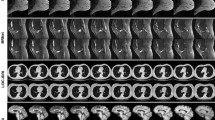Abstract
Image synthesis is increasingly being adopted in medical image processing, for example for data augmentation or inter-modality image translation. In these critical applications, the generated images must fulfill a high standard of biological correctness. A particular requirement for these images is global consistency, i.e an image being overall coherent and structured so that all parts of the image fit together in a realistic and meaningful way. Yet, established image quality metrics do not explicitly quantify this property of synthetic images. In this work, we introduce two metrics that can measure the global consistency of synthetic images on a per-image basis. To measure the global consistency, we presume that a realistic image exhibits consistent properties, e.g., a person’s body fat in a whole-body MRI, throughout the depicted object or scene. Hence, we quantify global consistency by predicting and comparing explicit attributes of images on patches using supervised trained neural networks. Next, we adapt this strategy to an unlabeled setting by measuring the similarity of implicit image features predicted by a self-supervised trained network. Our results demonstrate that predicting explicit attributes of synthetic images on patches can distinguish globally consistent from inconsistent images. Implicit representations of images are less sensitive to assess global consistency but are still serviceable when labeled data is unavailable. Compared to established metrics, such as the FID, our method can explicitly measure global consistency on a per-image basis, enabling a dedicated analysis of the biological plausibility of single synthetic images.
Access this chapter
Tax calculation will be finalised at checkout
Purchases are for personal use only
Similar content being viewed by others
References
Bińkowski, M., Sutherland, D.J., Arbel, M., Gretton, A.: Demystifying MMD GANs. In: International Conference on Learning Representations (2018)
Chen, T., Kornblith, S., Norouzi, M., Hinton, G.: A simple framework for contrastive learning of visual representations. In: International Conference on Machine Learning, pp. 1597–1607. PMLR (2020)
Chong, M.J., Forsyth, D.: Effectively unbiased FID and inception score and where to find them. In: Proceedings of the IEEE Computer Society Conference on Computer Vision and Pattern Recognition, pp. 6069–6078. IEEE Computer Society (2020)
Dhariwal, P., Nichol, A.: Diffusion models beat GANs on image synthesis. Adv. Neural. Inf. Process. Syst. 34, 8780–8794 (2021)
Esser, P., Rombach, R., Ommer, B.: Taming transformers for high-resolution image synthesis. In: Proceedings of the IEEE/CVF Conference on Computer Vision and Pattern Recognition, pp. 12873–12883 (2021)
Han, C., et al.: MADGAN: unsupervised medical anomaly detection GAN using multiple adjacent brain MRI slice reconstruction. BMC Bioinform. 22(2), 1–20 (2021)
He, K., Zhang, X., Ren, S., Sun, J.: Deep residual learning for image recognition. In: Proceedings of the IEEE Conference on Computer Vision and Pattern Recognition, pp. 770–778 (2016)
Heusel, M., Ramsauer, H., Unterthiner, T., Nessler, B., Hochreiter, S.: GANs trained by a two time-scale update rule converge to a local nash equilibrium. In: Advances in Neural Information Processing Systems, vol. 30 (2017)
Ho, J., Jain, A., Abbeel, P.: Denoising diffusion probabilistic models. Adv. Neural. Inf. Process. Syst. 33, 6840–6851 (2020)
Hong, S., et al.: 3D-StyleGAN: a style-based generative adversarial network for generative modeling of three-dimensional medical images. In: Engelhardt, S., et al. (eds.) DGM4MICCAI/DALI 2021. LNCS, vol. 13003, pp. 24–34. Springer, Cham (2021). https://doi.org/10.1007/978-3-030-88210-5_3
Hudson, D.A., Zitnick, C.L.: Generative adversarial transformers. In: Proceedings of the 38th International Conference on Machine Learning, ICML 2021 (2021)
Johnson, J., Gupta, A., Fei-Fei, L.: Image generation from scene graphs. In: Proceedings of the IEEE Conference on Computer Vision and Pattern Recognition, pp. 1219–1228 (2018)
Jung, S., Park, J., Seo, Y.G.: Relationship between arm-to-leg and limbs-to-trunk body composition ratio and cardiovascular disease risk factors. Sci. Rep. 11(1), 17414 (2021)
Karras, T., Laine, S., Aittala, M., Hellsten, J., Lehtinen, J., Aila, T.: Analyzing and improving the image quality of styleGAN. In: Proceedings of the IEEE/CVF Conference on Computer Vision and Pattern Recognition, pp. 8110–8119 (2020)
Kynkäänniemi, T., Karras, T., Laine, S., Lehtinen, J., Aila, T.: Improved precision and recall metric for assessing generative models. In: Advances in Neural Information Processing Systems, vol. 32 (2019)
Liang, J., et al.: NUWA-infinity: autoregressive over autoregressive generation for infinite visual synthesis. In: Oh, A.H., Agarwal, A., Belgrave, D., Cho, K. (eds.) Advances in Neural Information Processing Systems (2022)
Liu, B., Zhu, Y., Song, K., Elgammal, A.: Towards faster and stabilized GAN training for high-fidelity few-shot image synthesis. In: International Conference on Learning Representations (2021)
Liu, Y., et al.: CT synthesis from MRI using multi-cycle GAN for head-and-neck radiation therapy. Comput. Med. Imaging Graph. 91, 101953 (2021)
Mensing, D., Hirsch, J., Wenzel, M., Günther, M.: 3D (c) GAN for whole body MR synthesis. In: Mukhopadhyay, A., Oksuz, I., Engelhardt, S., Zhu, D., Yuan, Y. (eds.) DGM4MICCAI 2022. LNCS, vol. 13609, pp. 97–105. Springer, Cham (2022). https://doi.org/10.1007/978-3-031-18576-2_10
Menten, M.J., et al.: Exploring healthy retinal aging with deep learning. Ophthalmol. Sci. 3(3), 100294 (2023)
Parmar, G., Zhang, R., Zhu, J.Y.: On aliased resizing and surprising subtleties in GAN evaluation. In: CVPR (2022)
Pinaya, W.H., et al.: Brain imaging generation with latent diffusion models. In: Mukhopadhyay, A., Oksuz, I., Engelhardt, S., Zhu, D., Yuan, Y. (eds.) DGM4MICCAI 2022. LNCS, vol. 13609, pp. 117–126. Springer, Cham (2022). https://doi.org/10.1007/978-3-031-18576-2_12
Sajjadi, M.S., Bachem, O., Lucic, M., Bousquet, O., Gelly, S.: Assessing generative models via precision and recall. In: Advances in Neural Information Processing Systems, vol. 31 (2018)
Salimans, T., Goodfellow, I., Zaremba, W., Cheung, V., Radford, A., Chen, X.: Improved techniques for training GANs. In: Advances in Neural Information Processing Systems, vol. 29 (2016)
Sauer, A., Schwarz, K., Geiger, A.: StyleGAN-XL: scaling styleGAN to large diverse datasets. In: ACM SIGGRAPH 2022 Conference Proceedings, pp. 1–10 (2022)
Schaum, N., et al.: Ageing hallmarks exhibit organ-specific temporal signatures. Nature 583(7817), 596–602 (2020)
Sudlow, C., et al.: UK biobank: an open access resource for identifying the causes of a wide range of complex diseases of middle and old age. PLoS Med. 12(3), e1001779 (2015)
Sun, L., Chen, J., Xu, Y., Gong, M., Yu, K., Batmanghelich, K.: Hierarchical amortized GAN for 3d high resolution medical image synthesis. IEEE J. Biomed. Health Inform. 26(8), 3966–3975 (2022)
Tsitsulin, A., et al.: The shape of data: intrinsic distance for data distributions. In: International Conference on Learning Representations (2020)
Vaswani, A., et al.: Attention is all you need. In: Guyon, I., et al. (eds.) Advances in Neural Information Processing Systems, vol. 30. Curran Associates, Inc. (2017)
Zhang, H., Goodfellow, I., Metaxas, D., Odena, A.: Self-attention generative adversarial networks. In: International Conference on Machine Learning, pp. 7354–7363. PMLR (2019)
Zhang, R., Isola, P., Efros, A.A., Shechtman, E., Wang, O.: The unreasonable effectiveness of deep features as a perceptual metric. In: 2018 IEEE/CVF Conference on Computer Vision and Pattern Recognition (CVPR), pp. 586–595. IEEE Computer Society (2018)
Acknowledgments
This research has been conducted using the UK Biobank Resource under Application Number 87802. This work is funded by the Munich Center for Machine Learning. We thank Franz Rieger for his valuable feedback and discussions.
Author information
Authors and Affiliations
Corresponding author
Editor information
Editors and Affiliations
Rights and permissions
Copyright information
© 2024 The Author(s), under exclusive license to Springer Nature Switzerland AG
About this paper
Cite this paper
Scholz, D., Wiestler, B., Rueckert, D., Menten, M.J. (2024). Metrics to Quantify Global Consistency in Synthetic Medical Images. In: Mukhopadhyay, A., Oksuz, I., Engelhardt, S., Zhu, D., Yuan, Y. (eds) Deep Generative Models. MICCAI 2023. Lecture Notes in Computer Science, vol 14533. Springer, Cham. https://doi.org/10.1007/978-3-031-53767-7_3
Download citation
DOI: https://doi.org/10.1007/978-3-031-53767-7_3
Published:
Publisher Name: Springer, Cham
Print ISBN: 978-3-031-53766-0
Online ISBN: 978-3-031-53767-7
eBook Packages: Computer ScienceComputer Science (R0)





